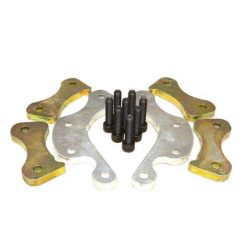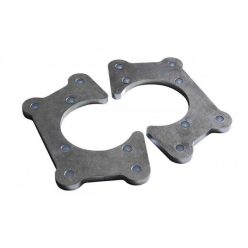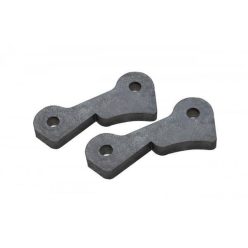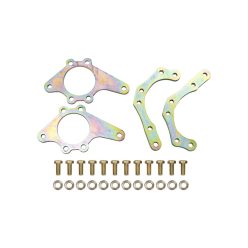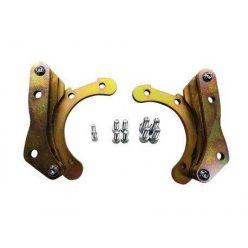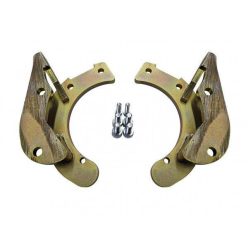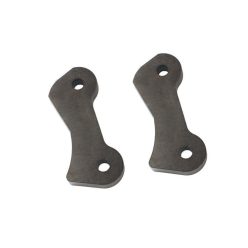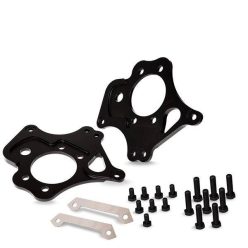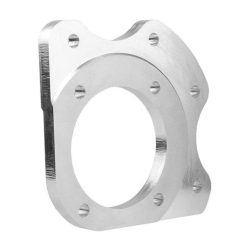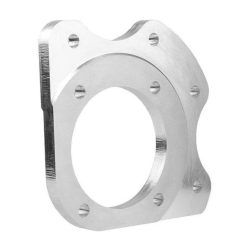The Caliper adapters and brackets category covers dedicated brake caliper adapters and mounting brackets for big brake conversions and additional rear calipers. Solutions from PMC, SWAGIER, CNC71 and MAZUR GARAGE allow, for example, BMW E30/E36 Compact to run E39 discs and calipers, Nissan S13–S15 to use Mercedes ML W163 calipers, or to mount extra rear calipers for drift hydraulic handbrakes.
Net price: 81 €
Net price: 64 €
Net price: 171 €
Net price: 139 €
Net price: 90 €
Net price: 69 €
Net price: 31 €
Net price: 184 €
Function and Main Benefits of Caliper Adapters
Caliper adapters and brackets are the key components that make big brake swaps and dual-caliper setups possible without redesigning the entire upright. They allow you to fit larger or different brake calipers and discs to your chassis, such as E39 brakes on BMW E30/E36 Compact or Mercedes ML W163 calipers on Nissan S-chassis cars. The range also includes dedicated drift solutions that mount an additional rear caliper for a separate hydraulic handbrake circuit while retaining the original footbrake caliper.
A well-engineered caliper adapter lets you take advantage of OEM performance calipers or motorsport units on platforms that were never delivered with such hardware from the factory. CNC-machined steel and aluminium combinations provide the stiffness required for precise braking while keeping unsprung weight under control. The products in this category come from brands such as PMC, SWAGIER, CNC71 and MAZUR GARAGE, whose parts are widely used on drift, time-attack and high-power road builds throughout Europe.
Technical Basics
Most caliper adapters are CNC-machined from high-strength steel or from a combination of steel and aluminium. For example, adapters for additional rear calipers on BMW E30/E36 Compact are specifically described as combining the stiffness and strength of steel with the low weight of aluminium, allowing an extra pair of calipers to be mounted on the rear discs for an independent circuit. Precise bolt-hole locations, bolt circles and offsets ensure that the new caliper is centred correctly over the disc.
The category includes various types of second caliper adapters for BMW E36 and E46 rear axles, which enable the installation of an extra caliper without welding or machining. These parts are typically used for hydraulic handbrakes while the factory caliper continues to serve the service brake circuit. Other adapters, such as those for Audi A6/S4/S6 C4, allow the original HP2 “UFO” rotors to be replaced or combined with BREMBO Z17/Z18 calipers, bringing more modern brake hardware to older performance platforms.
Many caliper brackets are designed to bridge specific disc and hub combinations. Examples include Nissan S13/S14/S15 to Mercedes ML W163 kits or adapters for Nissan 200SX. These solutions state clearly which disc diameters, thicknesses and calipers they support. Geometry is critical: the bracket not only sets the bolt pattern but also defines the caliper’s radial position and lateral offset relative to the disc centreline, ensuring correct pad sweep and even loading across the disc face.
Selection Criteria
Selecting the right caliper adapter starts with identifying your exact chassis and the disc–caliper combination you want to run. For BMW E30/E36 Compact, for instance, there are versions intended for stock E36 rear discs and calipers and others specifically designed for 298 mm E39 discs and calipers. The same applies to Nissan–Mercedes ML or Audi HP2–Brembo conversions: always verify the compatibility list by model, engine and year before ordering, rather than assuming all adapters are interchangeable.
Next, consider your intended use case: drag, drift, track day, time attack or fast road. Drift builds often rely on dual-caliper rear setups, making second-caliper adapters a priority; in such cases you must ensure the kit matches your existing disc and hub configuration and does not require welding. For big brake conversions on the front axle, choose brackets that have been engineered specifically for the disc diameter and caliper family you plan to use, rather than trying to adapt generic or “universal” hardware, which may compromise alignment and reliability.
Wheel fitment cannot be ignored either. Larger multi-piston calipers often demand 17–18" wheels, and spoke design is as important as diameter: an adapter can position the caliper in a way that clears the barrel but clashes with the spokes. Always check manufacturer templates or 1:1 printouts to confirm clearance, or consult a workshop that has already installed the same caliper bracket and wheel combination. Planning brakes, wheels and suspension as a system avoids expensive rework later.
Installation & Maintenance
Installing caliper adapters and brackets is a safety-critical operation that should ideally be carried out by an experienced technician or motorsport workshop. Brackets must be bolted to the upright or rear beam using appropriate high-strength fasteners (often class 10.9 or 12.9) torqued to the manufacturer’s specified torque values, typically with threadlocker. Mating surfaces should be clean and flat, with burrs removed and suitable washers under bolt heads and nuts to avoid localised stress concentration.
After installation, you must verify disc runout and caliper centring. If the disc does not sit in the caliper’s centreline, pistons can be overextended on one side, and pad loading will be uneven, leading to noise, vibration and premature wear. Dual-caliper rear setups also require full range-of-motion checks with suspension travel and steering lock, ensuring that lines and fittings clear bodywork and arms at all times. A short warning: a misaligned adapter can not only reduce braking performance but also damage calipers, discs and hubs in a very short time.
In ongoing maintenance, regularly inspect bolts, adapter surfaces and the areas around bolt holes. Any signs of cracking, elongation, discolouration or fretting indicate that the component should be replaced, even if the brakes still appear to function. For cars used on track or at drift events, it is wise to raise the car after each hard outing and visually check calipers, adapters, discs and hoses. On serious competition cars, many teams treat the caliper bracket as a periodic replacement item, swapping it after a set number of seasons or rotor lifecycles as cheap insurance.
FAQ
What are caliper adapters used for in drift cars?
Caliper adapters in drift applications are most commonly used to mount an additional rear caliper on each side for a separate hydraulic handbrake circuit. This allows the original caliper to remain on the footbrake circuit while the handbrake can be used aggressively without upsetting the main braking system or ABS/ESP.
Can I use a universal bracket with any caliper?
In theory, generic brackets can be made to work, but in practice it is risky. Bolt patterns, disc diameter, thickness and offset all need to match exactly, or you will end up with poor centring, uneven pad contact or wheel interference. Wherever possible, use application-specific adapters engineered for your exact disc and caliper combination.
Do caliper adapters need certification for road use?
Legal requirements vary by country. Some complete big brake kits include type approval or certification, while many custom or motorsport-only adapters do not. Always check local regulations before driving on public roads and choose components that meet the required standards if road legality is important to you.
Is it enough to swap adapters if I want bigger calipers?
Not always. Larger calipers may require bigger discs, different pads and even a different master cylinder to maintain correct pedal feel and brake balance. For best results, treat the braking system as a complete package and plan calipers, discs, pads, hydraulics and adapters together rather than changing one element in isolation.
How often should I inspect caliper adapters on a track car?
On cars used regularly for track days or drift events, it is good practice to inspect adapters, bolts and mounts after every hard event. Look for loosening, cracks or discolouration and address any issues immediately; the cost of replacement hardware is small compared to the consequences of a brake failure at speed.

